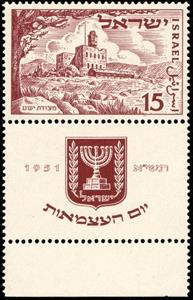Stamp with Collectible Margin: Metsudat Yesha (Israel 1951)
Metsudat Yesha (Israel 1951)
09 May (Israel ) within release 3rd Anniversary of Independence goes into circulation Stamp with Collectible Margin Metsudat Yesha face value 15 Israeli pruta
| Stamp with Collectible Margin Metsudat Yesha in catalogues | |
|---|---|
| Michel: | Mi: IL 57T |
| Stamp Number: | Sn: IL 46T |
| Yvert et Tellier: | Yt: IL 43T |
| Stanley Gibbons: | Sg: IL 56T |
Stamp with Collectible Margin is square format.
stamps without both parts of the tab are worth significantly less.Also in the issue 3rd Anniversary of Independence:
- Stamp with Collectible Margin - HaKastel face value 40;
- Stamp with Collectible Margin - Metsudat Yesha face value 15;
Stamp with Collectible Margin Metsudat Yesha it reflects the thematic directions:
An anniversary is the date on which an event took place or an institution was founded in a previous year, and may also refer to the commemoration or celebration of that event. For example, the first event is the initial occurrence or, if planned, the inaugural of the event. One year later would be the first anniversary of that event. The word was first used for Catholic feasts to commemorate saints. Most countries celebrate national anniversaries, typically called national days. These could be the date of independence of the nation or the adoption of a new constitution or form of government. The important dates in a sitting monarch's reign may also be commemorated, an event often referred to as a "Jubilee".
A fortification (also called a fort, fortress, fastness, or stronghold) is a military construction designed for the defense of territories in warfare, and is used to establish rule in a region during peacetime. The term is derived from Latin fortis ("strong") and facere ("to make").
A landscape is the visible features of an area of land, its landforms and how they integrate with natural or man-made features. A landscape includes the physical elements of geophysically defined landforms such as (ice-capped) mountains, hills, water bodies such as rivers, lakes, ponds and the sea, living elements of land cover including indigenous vegetation, human elements including different forms of land use, buildings and structures, and transitory elements such as lighting and weather conditions. Combining both their physical origins and the cultural overlay of human presence, often created over millennia, landscapes reflect a living synthesis of people and place that is vital to local and national identity. The character of a landscape helps define the self-image of the people who inhabit it and a sense of place that differentiates one region from other regions. It is the dynamic backdrop to people’s lives. Landscape can be as varied as farmland, a landscape park, or wilderness. The earth has a vast range of landscapes, including the icy landscapes of polar regions, mountainous landscapes, vast arid desert landscapes, islands and coastal landscapes, densely forested or wooded landscapes including past boreal forests and tropical rainforests, and agricultural landscapes of temperate and tropical regions.


